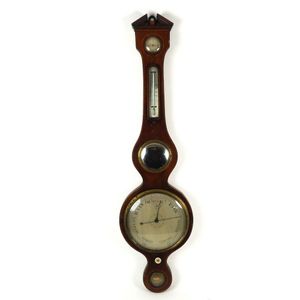Victorian Mahogany Banjo Barometer with Provenance
An early Victorian mahogany banjo barometer of impressive size, c.1845, with broken arch pediment, damp/dry dial, mercury thermometer and convex mirror to the trunk above a large silvered 10.5 inches (25 cm) main register signed Emery Churcher, the spirit level signed M.Fatorini, Chichester, height 117 cm. Provenance: Captain Clayton Matthew Thomas (1831-1922) by descent to our vendor. Clayton is renowned for his maritime paintings. After a distinguished career serving in a number of ships, including commanding the 'Kent' and the 'City of Brisbane' he settled in Auckland in 1864, appointed nautical assessor in the inquiry into the loss of S.S. Tauranga in 1871 and as a Surveyor for Lloyds in 1875.
You must be a subscriber, and be logged in to view price and dealer details.
Subscribe Now to view actual auction price for this item
When you subscribe, you have the option of setting the currency in which to display prices to $Au, $US, $NZ or Stg.
This item has been sold, and the description, image and price are for reference purposes only.
- Mahogany - Mahogany is a dense, close grained red-coloured timber from the West Indies and Central America. It was first imported into Europe in the the early 18th century and its use continued through the 19th century. It was popular for furniture making because of its strength, the wide boards available, the distinctive grain on some boards, termed flame mahogany and the rich warm colour of the timber when it was polished.. The "flame" was produced where a limb grew out from the trunk of the tree, and this timber was usually sliced into veneers for feature panels on doors, backs and cornices.
Some terms used to describe mahogany relate to the country from which it originally came, such as "Cuban" mahogany, "Honduras" mahogany etc. However unless the wood has been tested the names assigned are more a selling feature, rather than a true indication of the timber's origin. - Victorian Period - The Victorian period of furniture and decorative arts design covers the reign of Queen Victoria from 1837 to 1901. There was not one dominant style of furniture in the Victorian period. Designers used and modified many historical styles such as Gothic, Tudor, Elizabethan, English Rococo, Neoclassical and others, although use of some styles, such as English Rococo and Gothic tended to dominate the furniture manufacture of the period.
The Victorian period was preceded by the Regency and William IV periods, and followed by the Edwardian period, named for Edward VII (1841 ? 1910) who was King of the United Kingdom and the British Dominions and Emperor of India for the brief period from 1901 until his death in 1910.
This item has been included into following indexes:
- barometers, period or origin - Victorian period 113
- barometers, type
Visually similar items

Clement Meadmore & Michael Hirst set of six stools, plastic coated metal, original rope seat, Australia, c 1950s, 86 cm high, 36 cm wide, 49 cm deep
Sold by
in
for
You can display prices in $Au, $US, $NZ or Stg.

French Louis XV enfilade buffet
Sold by
in
for
You can display prices in $Au, $US, $NZ or Stg.

18ct yellow gold open locket, with printed picture, total weight: 8.88 grams, size: 4 cm including ring
Sold by
in
for
You can display prices in $Au, $US, $NZ or Stg.

A silver Gucci link necklace with parrot clasp. Weight 55g
Sold by
in
for
You can display prices in $Au, $US, $NZ or Stg.
